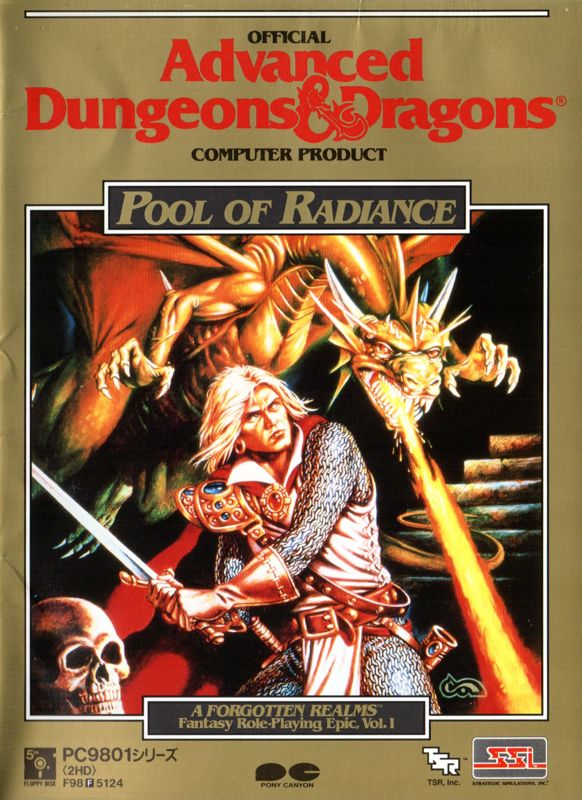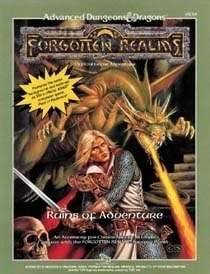No one masters a sword. The sword masters the man, and a cleric of Tyr serves no master but Tyr.
Pool of Radiance is a classic and early Forgotten Realms novel by James M. Ward (who passed away last year, around the time I read this) and Jane Cooper Hong. It was published in 1989 as
a tie-in to the 1998 gold box video game of the same name. It is book one in The Pools trilogy that is also called The Heroes of Phlan. Maybe the first video game tie in, the other would be Azure Bonds by Novak and Grubb (1988) tied into The Curse of the Azure Bonds (1989, the game a sequel to the novel and the Pool of Radiance game). Pool of Radiance is also based off the module Ruins of Adventure of which Ward was a writer for.Important note: this was my 100th Forgotten Realms fiction read. I decided to make this the milestone read after the recent passing of one of co-authors, Jim Ward.
While the story is known for Phlan on the Moonsea, it starts to the south, in Cormyr. Shal is looking for a spell ingredient, an herb called Wa. According to her master, Great Ranthor, it is a component for a dust for incendiary spells. She doesn’t succeed in mastering burning hands except by burning her hands. We learn a little of her training and the patience of her master, Ranthor.
Then scrying a crystal ball, Denlor, a friend of Ranthor’s and fellow mage, calls for aid against the monsters besetting him in Phlan. This doesn’t go to plan.
The characters are of course Shal Bal of Cormyr, mageling of a family of sellswords. Cerulean is her steed and familiar, there is some humor involved with this character. He can speak telepathically to her, run swifter than natural horses, never tires and can also turn invisible. Her story involves a physical transformation that is important to the theme of being comfortable with your own skin and I think while straightforward it is still well done. She’s about 19 years old in the story.
Ren o’ the Blade is the last, a thief of some experience and also a ranger. He waits tables in Phlan for the proprietor named Sot at the Laughing Goblin Inn, and hasn’t actually thieved for a year, not since the death of his girl, Tempest. This was because they got mixed up in some gems and ioun stones claimed by assassins. He’s had dozens of odd jobs since leaving Waterdeep. He is six and half feet tall and quiet. I believe he is the one on the cover. His introduction is the shortest but also tells us about the young adventurers looking for a name and money by clearing the ruins for the council of Phlan.
Of course there is the bronze dragon, Tyranthraxus who graces the cover. We learn even that Phlan had been leveled 50 years prior to events by dragons. The ruins in Old Phlan are now the dwelling of vile creatures and the river has been ichorized in the area. A certain pool of radiance comes into play too but is not evident from the start.
Quarrel is a good use of a half-orc character, and Cadorna is not a half-bad villain, though he isn’t the main one.
This story has orcs (the pig-shouted variety), zombies, skeletons, wraiths, a vampire, giants frogs, hobgoblins, kobolds, gnolls . It also has a hammer that works like a boomerang. There is a reversed trope, some tough women catcalling men patrons and workers.
We get a nice layout of Phlan, a map would have been great. The location feels liminal, civilization and the wilds right next to each other. Of course it’s up to the heroes to adventure into dangerous wilderness to tame it some but also to gain gold and experience, which are sometimes on-in-the-same. This is rather explicit, the nice part of town with humans being Civilized Phlan and the ruined part called the ruins, how apt. We get some vague ideas of the Moonsea area, which I’ve only really seen Zhentil Keep and Hillsfar so far, but Thentia is also mentioned here.
The vibe is different than other Realms novels. While there are place names and locals, there are generally curses to “gods”, and magical items are very generic sounding. It feels more like D&D generally, particularly with all the names spells, than Forgotten Realms specifically. This seems like a bad thing, and it can be at some angles, but it also makes it an easy introduction to the Realms. Many other novels are overwhelming and they feel like you’re missing something even if they’re first in a series or standalone. This goes away as you become more familiar, but you don’t really have that problem here.
It is also set in 1340 DR, which is considerably earlier than most tales, Azure Bonds being set in 1357 DR for example, and the rest are generally sequential. (Note, the story was originally set around 1357-1358 DR but did not incorporate Time of Troubles of material so had to be moved back to fit into lore). The protagonists are all very young, just around 20. This makes it rather young adult and easy to approach, sort of like the Dragonlance Chronicles.
(It’s not as epic, and the party doesn’t form right away, more like a modern epic fantasy that each POV is introduced before they be one together, and the third person narration is obviously omniscient. I think it works better than Dragonlance Chronicles and I personally would recommend young readers start here over the Chronicles. Though it’s still noticeable adult but essentially a lite version (like the Chronciles). This honestly made me feel like a kid again more than Dragonlance did, and I read both as an adult. I don’t think that’s just my Realms bias either. Heck, I felt something similar reading Saga of Old City just not in its sequel, Artifact of Evil.)
Maybe the friendship comes too quickly and too smoothly, and there is some angst in the form of a minor love triangle. The protagonists are also exceptionally capable and we don’t worry much for them after this becomes evident. Not my favorite tropes and this isn’t the highest literature but they did not bother me here. The pacing is done well and dialogue and character development exciting. It’s campy but a good example of how they can be worth your time. Not that this is for everyone, mind.
Also, it could have used better editing for sure; Ferran Martinez is an odd fantasy name; all the evil creatures are evil, don't expect nuance; and even those in poverty seem to be angles in a negative light. Regardless, I found it an Exceptional reading experience.
“Apart from their magic, the three probably make up the most physically powerful trio I have ever seen.”



No comments:
Post a Comment